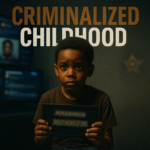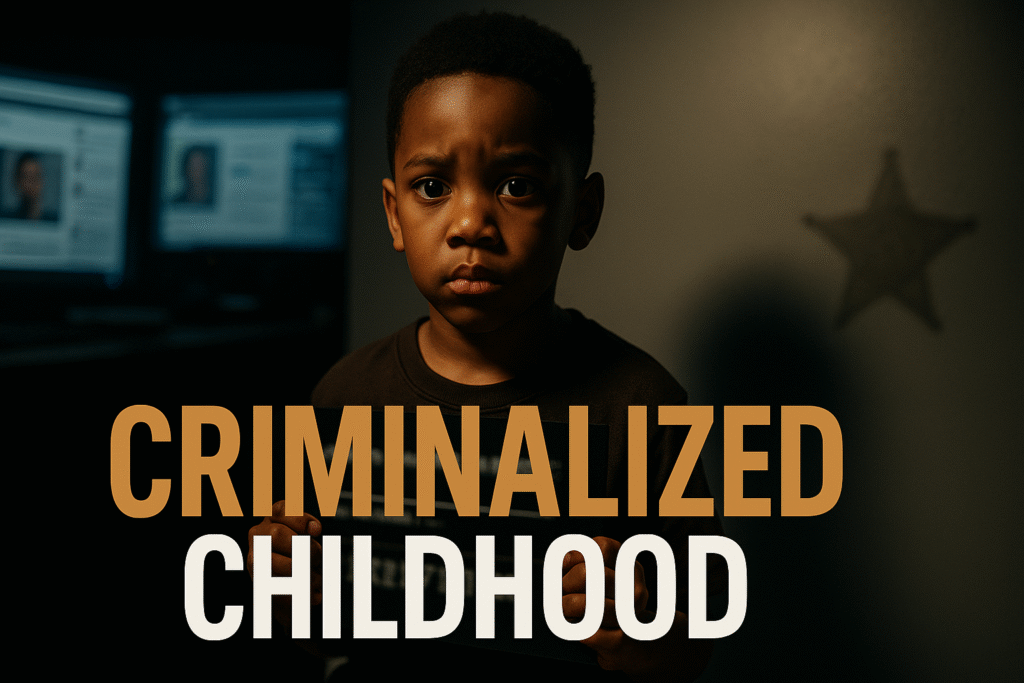

Putnam County Mugshot: Criminalizing Black Children in the Headlines
The History Behind The Headlines
By Darius Spearman (africanelements)
Support African Elements at patreon.com/africanelements and hear recent news in a single playlist. Additionally, you can gain early access to ad-free video content.
Introduction: Putnam County Mugshot Controversy and Black Child Criminalization
In mid-October, the Putnam County Sheriff’s Office in Florida posted the mugshot, full name, and arrest details of a nine-year-old Black boy after an incident at school involving an alleged pocketknife. The post spread widely on social media and drew immediate public outrage, especially from Black communities and civil-rights advocates. Many called the public posting an act of shaming that reflects a larger pattern: the overcriminalization of Black children. The sheriff’s office defended the post by citing policy and state law as authority for releasing juvenile felony arrest information. However, the backlash was swift and emotional, as communities described the post as adultifying and harmful to a child’s future (Black Information Network: https://www.binnews.com/content/2025-10-17-sheriffs-office-faces-backlash-for-posting-9-year-old-black-boys-mugshot/; Atlanta Black Star: https://atlantablackstar.com/2025/10/16/florida-sheriffs-office-stands-by-decision-to-post-9-year-old-black-boys-mugshot-on-social-media/).
Detailed Analysis of the Current News Story and Law
Following the school incident, Putnam County deputies arrested the child and charged him with aggravated assault with a deadly weapon without intent to kill. Consequently, the sheriff’s office posted the child’s booking photo and information on its Facebook page. Although the agency characterized the action as lawful and part of a public-safety policy adopted in 2018, thousands reacted online, criticizing the choice to identify and shame a child so young (WFLA/Newsradio WFLA Orlando: https://wflaorlando.iheart.com/featured/florida-news/content/2025-10-14-florida-sheriffs-office-faces-backlash-for-posting-9-year-olds-mugshot/).
Criminalization of Children
When everyday behaviors or minor infractions are handled through arrests and formal legal charges instead of counseling, school supports, or diversion programs.
School-to-Prison Pipeline
Systems of school discipline and policing that increase the likelihood of students entering the juvenile and adult criminal systems.
Adultification Bias
A cognitive bias where Black children are perceived as older and less innocent, lowering empathy and increasing punitive responses.
Moreover, reporting indicates the sheriff’s office argued that state juvenile confidentiality statutes permit release of juvenile booking information in certain felony cases. That defense resonated with some citizens who saw the post as transparency; however, advocates emphasized that legal permissibility is not the same as moral or best-practice policing. The public-record release of a child’s image has consequences for schooling, family privacy, and long-term stigma. National attention intensified because the incident evokes deep, historical patterns of publicly branding Black youth as culpable and dangerous (New York Post: https://nypost.com/2025/10/15/us-news/mug-shot-of-9-year-old-boy-posted-by-florida-sheriffs-office-sees-swift-furious-backlash/).
Historical Context: School-to-Prison Pipeline and Racial Disparities in Juvenile Justice
To understand why this headline reverberated, consider the long history of Black children being funneled into punitive systems. For decades, scholars and advocates have documented a “school-to-prison pipeline,” where disciplinary policies, resource officers in schools, and law-enforcement referrals increase young peoples’ contact with the juvenile justice system. Consequently, Black students are disproportionately arrested for school-based incidents compared to white students, even when the infractions are similar (ACLU school-to-prison pipeline overview: https://www.aclu.org/issues/racial-justice/race-and-inequality-education/school-prison-pipeline).
In addition to school practices, nationwide juvenile-placement statistics show stark racial disparities. The Sentencing Project notes Black youth are placed in juvenile facilities at rates many times higher than white youth; these placement disparities contribute to lifelong collateral consequences including disrupted education and greater likelihood of adult incarceration (Sentencing Project fact sheet: https://www.sentencingproject.org/fact-sheet/black-disparities-in-youth-incarceration/).
Historical Context: Adultification, Media, and Public Shaming of Black Children
Another critical thread is adultification bias — the perception that Black children are older, more culpable, and less deserving of childhood leniency than white peers. This bias increases the odds of police involvement and harsher punishment for Black children. Over time, such perceptions became normalized through media portrayals and certain policing practices, further entrenching unequal treatment. The Putnam County post feeds into that legacy by publicly framing a nine-year-old as a criminal actor rather than a child in need of family and therapeutic support (ACLU resources on discriminatory school discipline: https://www.aclu.org/issues/racial-justice/race-and-inequality-education/school-prison-pipeline).
Timeline: How Juvenile Mugshot Posting Became a Contested Practice
Early 2000s — Local law enforcement increasingly uses online platforms to post arrest photos and press releases.
2010s — Social media expands reach; some sheriffs begin posting juvenile images in severe cases as a deterrent.
2020s — Civil-rights groups and journalists push back, documenting racial impacts and calling for policy limits.
Present — Putnam County incident sparks renewed debate about legality, ethics, and harm to Black children (coverage: BIN, ABlackStar, WFLA).
Historically, public exposure of alleged juvenile wrongdoing has taken many forms: newspaper mugshots in earlier eras, televised court footage, and today’s social-media posts by official agencies. Each iteration amplifies stigma and can limit rehabilitation options. Thus, the choice to make a juvenile’s image viral does more than inform the public; it creates an indelible digital record that follows a child into adulthood and applies disproportionate harm to Black children who are already overrepresented in the system (Sentencing Project juvenile statistics: https://www.sentencingproject.org/fact-sheet/black-disparities-in-youth-incarceration/).
Why This Matters Today: Policy, Public Safety, and Community Trust
First, the incident raises urgent policy questions about the limits of public disclosure. Even if a statute permits disclosure, agencies must weigh rehabilitative needs and the harms of public shaming. Second, community trust is at stake. Many Black families see such public exposures as evidence that law enforcement treats their children differently; consequently, trust in policing and cooperation with investigations erode. Therefore, transparency alone is not an adequate defense when it undermines long-term public-safety goals by alienating communities and harming children.
Third, the case points to concrete reform options that evidence and advocates recommend. These include expanding diversion and restorative practices in schools, limiting arrests for minor school incidents, developing protective policies to prevent public posting of juvenile images, and requiring trauma-informed responses to incidents involving children. Such reforms aim to reduce juvenile-system contact and mitigate the profound consequences of early labeling and stigmatization (Sentencing Project recommendations and statistics: https://www.sentencingproject.org/fact-sheet/black-disparities-in-youth-incarceration/; ACLU school-to-prison pipeline resources: https://www.aclu.org/issues/racial-justice/race-and-inequality-education/school-prison-pipeline).
Each of these visualizations is optimized for responsive embedding and follows the African Elements color palette to maintain editorial clarity and accessibility. They are meant to accompany the narrative above and help readers quickly grasp definitions, scale, and the historical arc of the practice.
Conclusion: Why the Putnam County Mugshot Case Matters for Black Communities
Ultimately, the Putnam County posting matters because it is symptomatic of larger systems that disproportionately harm Black children. The immediate harm is public shaming and stigma. The downstream harms are educational disruption, psychological distress, and heightened odds of continued contact with the justice system. Thus, debates about legality are important, but policy choices about discretion, trauma-informed responses, and diversion are equally important. Communities seeking both safety and justice will push for alternatives that reduce arrests, protect children’s privacy, and restore trust between Black communities and law enforcement (Sentencing Project: https://www.sentencingproject.org/fact-sheet/black-disparities-in-youth-incarceration/; ACLU: https://www.aclu.org/issues/racial-justice/race-and-inequality-education/school-prison-pipeline).
Police agencies can comply with transparency laws and still prioritize children’s futures. For instance, agencies might adopt policies that forbid public posting of juvenile images except in narrowly defined, imminent-threat circumstances and that require immediate removal when families request it. In addition, counties could invest in school-based mental-health services, restorative justice practices, and diversion programs to avoid the harms of early system involvement. These are practical reforms that aim to reduce racial disparities in juvenile outcomes while protecting public safety.
ABOUT THE AUTHOR
Darius Spearman has been a professor of Black Studies at San Diego City College since 2007. He is the author of several books, including Between The Color Lines: A History of African Americans on the California Frontier Through 1890. You can visit Darius online at africanelements.org.
